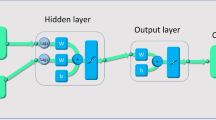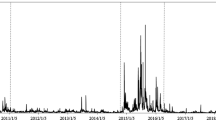Abstract
As a forward-looking measure of future equity market volatility, the VIX index has gained immense popularity in recent years to become a key measure of risk for market analysts and academics. We consider discrete reported intraday VIX tick values as realisations of a collection of curves observed sequentially on equally spaced and dense grids over time and utilise functional data analysis techniques to produce 1-day-ahead forecasts of these curves. The proposed method facilitates the investigation of dynamic changes in the index over very short time intervals as showcased using the 15-s high-frequency VIX index values. With the help of dynamic updating techniques, our point and interval forecasts are shown to enjoy improved accuracy over conventional time series models.





Similar content being viewed by others
Notes
The use of 15-s frequency is because it is the highest frequency available for the VIX index. Some of its derivatives may trade at a higher frequency, but the index value is only recalculated and released on a 15-s basis. So to provide us with the most current information and the highest level of granularity to model its evolution, we use these 15-s VIX quotes. This data frequency is particularly relevant for the dynamic functional time series approaches we propose.
The proportion of outlying curves is specified to be around 5% which is an arbitrary but commonly used threshold in functional data analysis.
A comprehensive discussion of these special economic events leading to unusual market movements are included in our Supplement.
Horváth and Kokoszka (2012) compared different methods of selecting the number of retained functional principal components and argued that the cumulative percentage of total variance method worked best throughout applications in their book. Hence, we have adopted this method in our study of VIX.
When updating point forecasts for a particular day, we keep using the same K obtained in the model estimation step as per Eq. (3).
MCPDC of TS: max 63.75%, mean 60.48%; MCPDC of BM: max 70.47%, mean 60.88%; MCPDC of PLS: max 88.50%, mean 75.22%; MCPDC of RR: max 85.75% mean 76.98%; MCPDC of FLR: max 88.95% mean 79.13%.
References
Aneiros-Pérez, G., & Vieu, P. (2008). Nonparametric time series prediction: A semi-functional partial linear modeling. Journal of Multivariate Analysis, 99(5), 834–857.
Aue, A., Norinho, D. D., & Hörmann, S. (2015). On the prediction of stationary functional time series. Journal of the American Statistical Association, 110(509), 378–392.
Bali, T. G., & Theodossiou, P. (2007). A conditional-SGT-VaR approach with alternative GARCH models. Annals of Operations Research, 151(1), 241–267.
Bernales, A., & Guidolin, M. (2014). Can we forecast the implied volatility surface dynamics of equity options? Predictability and economic value tests. Journal of Banking & Finance, 46, 326–342.
Besse, P., Cardot, H., & Stephenson, D. (2000). Autoregressive forecasting of some functional climatic variations. Scandinavian Journal of Statistics, 27(4), 673–687.
Bosq, D. (2000). Linear processes in function spaces. Lecture Notes in Statistics, New York.
Brailsford, T. J., & Faff, R. W. (1996). An evaluation of volatility forecasting techniques. Journal of Banking & Finance, 20(3), 419–438.
Chatfield, C. (1993). Calculating interval forecasts. Journal of Business & Economic Statistics, 11(2), 121–135.
Chiou, J.-M., et al. (2012). Dynamical functional prediction and classification, with application to traffic flow prediction. The Annals of Applied Statistics, 6(4), 1588–1614.
Diebold, F. X., & Mariano, R. S. (2002). Comparing predictive accuracy. Journal of Business & Economic Statistics, 20(1), 134–144.
Dunis, C. L., Likothanassis, S. D., Karathanasopoulos, A. S., Sermpinis, G. S., & Theofilatos, K. A. (2013). A hybrid genetic algorithm-support vector machine approach in the task of forecasting and trading. Journal of Asset Management, 14(1), 52–71.
Febrero, M., Galeano, P., & González-Manteiga, W. (2007). A functional analysis of NOx levels: Location and scale estimation and outlier detection. Computational Statistics, 22(3), 411–427.
Fernandes, M., Medeiros, M. C., & Scharth, M. (2014). Modeling and predicting the CBOE market volatility index. Journal of Banking & Finance, 40, 1–10.
Fuertes, A.-M., Izzeldin, M., & Kalotychou, E. (2009). On forecasting daily stock volatility: The role of intraday information and market conditions. International Journal of Forecasting, 25(2), 259–281.
Gabriel, K. R., & Zamir, S. (1979). Lower rank approximation of matrices by least squares with any choice of weights. Technometrics, 21(4), 489–498.
Gabrys, R., Horváth, L., & Kokoszka, P. (2010). Tests for error correlation in the functional linear model. Journal of the American Statistical Association, 105(491), 1113–1125.
Gneiting, T., & Katzfuss, M. (2014). Probabilistic forecasting. Annual Review of Statistics and Its Application, 1, 125–151.
Gneiting, T., & Raftery, A. E. (2007). Strictly proper scoring rules, prediction, and estimation. Journal of the American Statistical Association, 102(477), 359–378.
Hall, P. (2011). Principal component analysis for functional data: Methodology, theory and discussion. In F. Ferraty & Y. Romain (Eds.), The Oxford handbook of functional data analysis (pp. 210–234). Oxford: Oxford University Press.
Hall, P., & Vial, C. (2006). Assessing the finite dimensionality of functional data. Journal of the Royal Statistical Society: Series B (Statistical Methodology), 68(4), 689–705.
Hays, S., Shen, H., & Huang, J. Z. (2012). Functional dynamic factor models with application to yield curve forecasting. The Annals of Applied Statistics, 6(3), 870–894.
Hoerl, A. E., & Kennard, R. W. (1970). Ridge regression: Biased estimation for nonorthogonal problems. Technometrics, 12(1), 55–67.
Hörmann, S., Horváth, L., & Reeder, R. (2013). A functional version of the ARCH model. Econometric Theory, 29(2), 267–288.
Horváth, L., & Kokoszka, P. (2012). Inference for functional data with applications. New York: Springer.
Huang, J. Z., Shen, H., & Buja, A. (2009). The analysis of two-way functional data using two-way regularized singular value decompositions. Journal of the American Statistical Association, 104(488), 1609–1620.
Huber, P. J., & Ronchetti, E. M. (2009). Robust statistics. Hoboken, NJ: Wiley.
Hubert, M., Rousseeuw, P. J., & Verboven, S. (2002). A fast method for robust principal components with applications to chemometrics. Chemometrics and Intelligent Laboratory Systems, 60(1), 101–111.
Hyndman, R., Athanasopoulos, G., Bergmeir, C., Caceres, G., Chhay, L., O’Hara-Wild, M., et al. (2018). forecast: Forecasting functions for time series and linear models. R Package Version 8.4. https://CRAN.R-project.org/package=forecast
Hyndman, R. J., & Khandakar, Y. (2008). Automatic time series for forecasting: The forecast package for R. Journal of Statistical Software, 27(3), 1–22.
Hyndman, R. J., & Shang, H. L. (2009). Forecasting functional time series (with discussions). Journal of the Korean Statistical Society, 38(3), 199–221.
Hyndman, R. J., & Shang, H. L. (2010). Rainbow plots, bagplots, and boxplots for functional data. Journal of Computational and Graphical Statistics, 19(1), 29–45.
Hyndman, R. J., & Ullah, M. S. (2007). Robust forecasting of mortality and fertility rates: A functional data approach. Computational Statistics & Data Analysis, 51(10), 4942–4956.
Karhunen, K. (1946). Zur spektraltheorie stochastischer prozesse. Annales Academiae Scientiarum Fennicae, AI, 37, 1–37.
Kearney, F., Cummins, M., & Murphy, F. (2018). Forecasting implied volatility in foreign exchange markets: A functional time series approach. The European Journal of Finance, 24(1), 1–18.
Kılıç, D. K., & Uǧur, O. (2018). Multiresolution analysis of S&P500 time series. Annals of Operations Research, 260(1–2), 197–216.
Klepsch, J., & Klüppelberg, C. (2016). An innovations algorithm for the prediction of functional linear processes. Working paper, Technische Universität München. https://arxiv.org/abs/1607.05874
Klepsch, J., Klüppelberg, C., & Wei, T. (2017). Prediction of functional ARMA processes with an application to traffic data. Econometrics and Statistics, 1, 128–149.
Kokoszka, P., Miao, H., & Zhang, X. (2014). Functional dynamic factor model for intraday price curves. Journal of Financial Econometrics, 13(2), 456–477.
Kokoszka, P., & Reimherr, M. (2013). Determining the order of the functional autoregressive model. Journal of Time Series Analysis, 34(1), 116–129.
Kokoszka, P., & Reimherr, M. (2017). Introduction to functional data analysis. Boca Raton, FL: CRC Press.
Kokoszka, P., Rice, G., & Shang, H. L. (2017). Inference for the autocovariance of a functional time series under conditional heteroscedasticity. Journal of Multivariate Analysis, 162, 32–50.
Konstantinidi, E., & Skiadopoulos, G. (2011). Are VIX futures prices predictable? An empirical investigation. International Journal of Forecasting, 27(2), 543–560.
Konstantinidi, E., Skiadopoulos, G., & Tzagkaraki, E. (2008). Can the evolution of implied volatility be forecasted? Evidence from European and US implied volatility indices. Journal of Banking & Finance, 32(11), 2401–2411.
Kourtis, A., Markellos, R. N., & Symeonidis, L. (2016). An international comparison of implied, realized, and GARCH volatility forecasts. Journal of Futures Markets, 36(12), 1164–1193.
Li, D., Robinson, P. M., & Shang, H. L. (2018). Long-range dependent curve time series. Journal of the American Statistical Association: Theory and Methods under revision.
Loève, M. (1946). Fonctions aléatoires à décomposition orthogonale exponentielle. La Revue Scientifique, 84, 159–162.
Maronna, R., Martin, R. D., & Yohai, V. (2006). Robust statistics. Chichester, West Sussex: Wiley.
Morris, J. S. (2015). Functional regression. Annual Review of Statistics and Its Application, 2, 321–359.
Müller, H.-G. (2005). Functional modelling and classification of longitudinal data. Scandinavian Journal of Statistics, 32(2), 223–240.
Müller, H.-G., Sen, R., & Stadtmüller, U. (2011). Functional data analysis for volatility. Journal of Econometrics, 165(2), 233–245.
Peña, D., & Sánchez, I. (2007). Measuring the advantages of multivariate versus univariate forecasts. Journal of Time Series Analysis, 28(6), 886–909.
Psaradellis, I., & Sermpinis, G. (2016). Modelling and trading the U.S. implied volatility indices. Evidence from the VIX, VXN and VXD indices. International Journal of Forecasting, 32(4), 1268–1283.
R Core Team. (2018). R: A language and environment for statistical computing. R Foundation for Statistical Computing, Vienna, Austria. https://www.R-project.org/.
Ramsay, J. O., & Silverman, B. W. (2005). Functional data analysis (2nd ed.). New York: Springer.
Rice, J. A., & Silverman, B. W. (1991). Estimating the mean and covariance structure nonparametrically when the data are curves. Journal of the Royal Statistical Society Series B (Methodological), 1, 233–243.
Sermpinis, G., Stasinakis, C., Theofilatos, K., & Karathanasopoulos, A. (2014). Inflation and unemployment forecasting with genetic support vector regression. Journal of Forecasting, 33(6), 471–487.
Sguera, C., Galeano, P., & Lillo, R. E. (2016). Functional outlier detection by a local depth with application to NOx levels. Stochastic Environmental Research and Risk Assessment, 30(4), 1115–1130.
Shang, H. L. (2014). A survey of functional principal component analysis. AStA Advances in Statistical Analysis, 98(2), 121–142.
Shang, H. L. (2017). Forecasting intraday S&P 500 index returns: A functional time series approach. Journal of Forecasting, 36(7), 741–755.
Shang, H. L. (2018). Bootstrap methods for stationary functional time series. Statistics and Computing, 28(1), 1–10.
Shang, H. L., & Hyndman, R. J. (2011). Nonparametric time series forecasting with dynamic updating. Mathematics and Computers in Simulation, 81(7), 1310–1324.
Shen, H. (2009). On modeling and forecasting time series of smooth curves. Technometrics, 51(3), 227–238.
Tsay, R. S. (2013). Multivariate time series analysis: With R and financial applications. Hoboken, NJ: Wiley.
Vinod, H. D. (2004). Ranking mutual funds using unconventional utility theory and stochastic dominance. Journal of Empirical Finance, 11(3), 353–377.
Vinod, H. D., López-de Lacalle, J., et al. (2009). Maximum entropy bootstrap for time series: The meboot R package. Journal of Statistical Software, 29(5), 1–19.
Wang, L., & Zhu, J. (2010). Financial market forecasting using a two-step kernel learning method for the support vector regression. Annals of Operations Research, 174(1), 103–120.
Whaley, R. E. (2000). The investor fear gauge. The Journal of Portfolio Management, 26(3), 12–17.
Xu, J. (1999). Modeling Shanghai stock market volatility. Annals of Operations Research, 87, 141–152.
Yao, F., Müller, H.-G., & Wang, J.-L. (2005). Functional data analysis for sparse longitudinal data. Journal of the American Statistical Association, 100(470), 577–590.
Zhang, L., Shen, H., & Huang, J. Z. (2013). Robust regularized singular value decomposition with application to mortality data. The Annals of Applied Statistics, 7(3), 1540–1561.
Acknowledgements
The authors thank insightful comments and suggestions from three reviewers. The first author acknowledges a faculty research grant from the College of Business and Economics at the Australian National University. The second author would like to acknowledge financial support from the Australian Government Research Training Program Stipend Scholarship.
Author information
Authors and Affiliations
Corresponding author
Electronic supplementary material
Below is the link to the electronic supplementary material.
Rights and permissions
About this article
Cite this article
Shang, H.L., Yang, Y. & Kearney, F. Intraday forecasts of a volatility index: functional time series methods with dynamic updating. Ann Oper Res 282, 331–354 (2019). https://doi.org/10.1007/s10479-018-3108-4
Published:
Issue Date:
DOI: https://doi.org/10.1007/s10479-018-3108-4




